Anthony Albanese wants to change Australia and the Indigenous voice to parliament is only part of the story
A year into office, Anthony Albanese presides over an activist government that is fundamentally reshaping this country. Is he still a radical, but in disguise?

It is Sunday afternoon at The Lodge. Anthony Albanese is returning to Canberra from Brisbane. The gate cranks open, the prime ministerial convoy crunches the gravel and the first to greet Albanese is his tiny white cavoodle, Toto. Scooping her up into his arms and relaxing into a lounge in the sitting room of the Georgian Revival style residence, he explains that Toto is a priority on arriving home. “I have to do this first,” he says, leaning back and patting her all over to calm her down.
The Lodge is home for Albanese, who this month marks one year as prime minister. He prefers it to the Gothic style Kirribilli House, with lawns sloping towards Sydney Harbour, because it is more private, quiet and a place where he can relax. “People expect to see the prime minister in Canberra,” he tells me. “When I walk Toto, people just respectfully say ‘hello’ and don’t ask for selfies. It’s nice.” Albanese believes the prime minister should live and work in the national capital.
It’s not something many would have predicted long ago, but Albanese styles himself as a traditional prime minister. “I am a respecter of institutions,” he confirms. Living full-time in The Lodge is part of it. Elected to parliament in 1996 as the member for Grayndler in Sydney’s inner west, Albanese witnessed six prime ministers come and go. Along the way, he absorbed critical lessons from past governments: the importance of conventional cabinet practice; respectful public service relations; process-driven policymaking; a united caucus and disciplined party machine; and an emphasis on narrative to explain decisions.
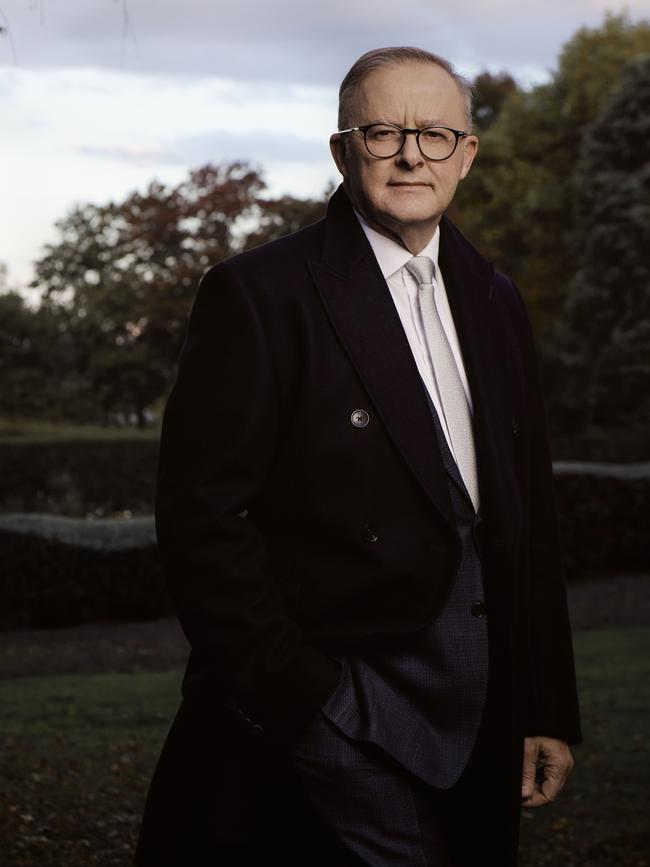
And so, before the 2022 election, Albanese and Treasurer Jim Chalmers preached the mantra of “safe change”. The policy changes they proposed on climate change, energy, infrastructure, skills, childcare, medicines, lifting minimum wages, paid family and domestic violence leave, an integrity commission and constitutional recognition for indigenous Australians all enjoyed broad support. But perhaps more crucially for an electorate with lingering bad memories of Labor governments past, Albanese promised they would be delivered with transparency and accountability, less conflict and more co-operation with business, unions and state governments. The promise was a Bob Hawke-Paul Keating model of governance rather than Kevin Rudd. The model recalls John Howard’s government while avoiding the division, dysfunction and secrecy that marked the governments of Tony Abbott, Malcolm Turnbull and Scott Morrison.
A year on, Albanese inhabits the conventional style. But it masks a government fundamentally reshaping national public policy settings. A government that is transformative in ambition and audacious in design. Consider the expanding role of government in the energy market and addressing climate change, manufacturing, environmental protection, housing and renters’ rights, and workplace relations. The biggest reforms to the Reserve Bank, immigration policy and Medicare in generations, plus a redesign of the NDIS, the most significant defence reorganisation since World War II, and a referendum to enshrine an Indigenous advisory body in the constitution. This is a quiet revolution in the making.
Does Albanese accept that he is leading an activist, interventionist government, enlarging its reach across society, the environment and the economy – cloaked in a traditional, process-driven approach that is masking how significant these changes really are? “Yeah, I do,” he responds, leaning forward. Does he see himself leading an ambitious, reformist government? “I want to change Australia for the better,” he replies. “We live in an economy and a society that is increasingly globalised ... with new technology the pace of change is faster today than it was 10 years ago, and that was faster than it was 20 years ago ... so, you need government to be prepared to do things and to lead.” Warming to his theme, Albanese adds: “We [are] aimed at transformative reforms.” Is this what he believes Labor governments should always do? Is it also in Albanese’s DNA that governments should seek to change the country significantly and change lives too? “Absolutely,” he responds. To be sure, he has lived it. The Albanese story – growing up in public housing with his mother, Maryanne, on a disability pension – is well told. He knows what governments can do. “I want to make a difference each and every day,” he says. It’s perfect timing for Albanese. He knows that there is, post GFC and pandemic, an appetite for a bigger government role in the economy and society for those caught in the trap of intergenerational inequality and prolonged low wage growth.
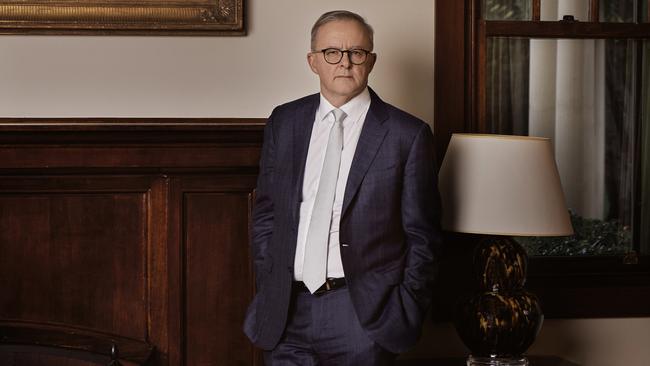
Albanese says he has set out to do what he promised to do in his first year. (Expanding paid parental leave by six weeks to up to 26 weeks is a notable addition.) “I’ve outlined very clearly what we’re going to do, what the short term objective is, but also what the longer term objective is, and then set about doing it,” he says. “I’ve tried to bring Australians into my confidence … and the feedback I get from people is that the mood in the country has changed.” He rejects criticism there have been too many policy reviews, arguing it is part of “methodical, competent, professional government”. International policy has commanded much of his time, from the Quad Leaders’ Summit in Tokyo and G20 in Bali to the Queen’s funeral and King’s coronation in London, a visit to Kyiv to meet Volodymyr Zelenskyy and the AUKUS pathway announcement in San Diego with Joe Biden and Rishi Sunak.
Before claiming Australia’s top job, Albanese had only had one meal at The Lodge. He had not been upstairs. He is not conscious of the ghosts of prime ministers past but takes in “the sense of history”. He made use of the pool in warmer months and occasionally plays tennis before breakfast but, at age 60, the hard surface has wreaked havoc on his knees. His favourite room is the drawing room, with wrap-around windows framing the trees and flowers, with a glimpse of the pool installed by John Gorton.
His partner Jodie Haydon – who chats to staff while he is photographed – splits her time between Canberra and Sydney. She helped him select art from the National Gallery of Australia to adorn the walls. There are a few Jeffrey Smart paintings, a Brett Whiteley and many indigenous art and artefacts. Albanese tells me his favourite is the large Anoranngait, Healing Plant by Emily Kame Kngwarreye from Central Australia. There are personal touches: birthday cards along the fireplace mantle, photos of family and friends, a pile of records. Albanese relaxes by playing billiards upstairs – also a favourite pastime of Robert Menzies. He has a few books on the go, stacked by his bedside, and listens to music. He picks up a signed U2 box set and lowers the needle on a record. As music filters through The Lodge, Albanese says he has kept up his strict diet and health regime. “I’ve never felt better,” he says. He dropped about 20kg, upgraded his wardrobe and bought new spectacles in the lead-up to the last election. It was a glow-up, pundits said. It showed he was hungry, ready and fit for purpose: being prime minister.

“I didn’t go into Parliament expecting to be prime minister,” Albanese tells me a few days later in his Sydney office high above the city with a view to Circular Quay. “Because I didn’t have that sense of destiny or preordained right to the job, I think I’m more relaxed in the job.” It’s the sort of thing he’s fond of saying – a signal to all that power hasn’t gone to his head. Prime Ministers get accustomed to the accoutrements of office and hubris can seep in. David Owen, a former UK Labour minister, argues hubris manifests the longer a person exercises power. Albanese, for now at least, seems grounded, aware of his strengths and mindful of his limitations. “You can’t learn about the job of prime minister from reading about it or thinking about it as much as you can by doing it,” Albanese says.
Tieless and sans jacket, sitting in a white leather armchair with a notepad in hand, embossed with “Prime Minister” across the top, Albanese glances at his jottings in thick blue marker. “In the first 12 months,” he says, “the character of a government is demonstrated.” Critical, in this respect, has been his chosen leadership style. “I’m captain of the team, but I’m not trying to kick every goal or make every tackle,” he says. He urged ministers to take responsibility for their portfolios. He met with them about their agenda and shared it with other ministers. They have been encouraged to have their say in cabinet, even if it runs counter to the mood. There have been no high-level leaks. Albanese encouraged ministers to respect the public service and meet with departmental staff. He has engaged with stakeholders: business, unions, NGOs. “They might not get the answers they want, but they will always get a hearing,” he says. And, he says, his government has sought to continually communicate with voters about what they are doing and why.
It was Howard who said the most important relationship a leader has is with their MPs, and it helps explain why he never faced a leadership challenge in government. Albanese, following suit, operates an open-door policy with MPs. There is no staff gatekeeping; any meeting requested will be scheduled. He has not attended Left faction meetings since becoming party leader in 2019 but he meets with faction representatives. Over the past four years there have been no votes on Labor’s national executive, which is split 10 from the Right and 10 from the Left with Albanese holding a casting vote. It too operates by consensus.
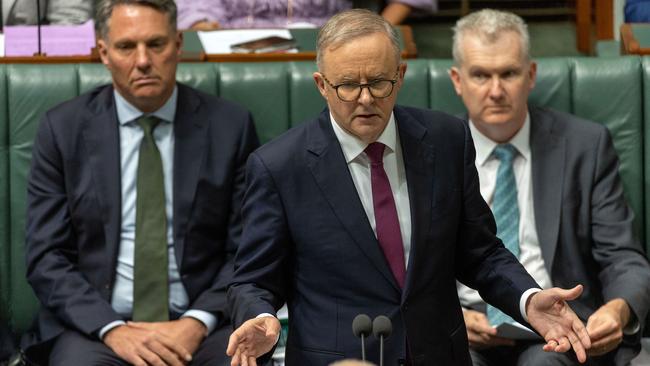
For those of us with memories of Albanese 1.0, the factional warrior and proud left-wing ideologue who had a chip on his shoulder, nursed grudges, and famously said “I like fighting Tories”, Albanese 2.0 has been a revelation. In Young Labor, Albanese had identified as a radical socialist and opposed tariff cuts, privatisation, financial market deregulation, university fees, nuclear power and uranium mining. But he has surrendered dogmatism for pragmatism in pursuit of power. He had to; Albanese 1.0 was unelectable. “I am much more respectful of differences of view than when I was 21,” he told me in a previous interview, before becoming prime minister, “but I’m no less passionate than I was then.” He jettisoned support for wealth taxes and death duties, no longer opposes refugee boat turn-backs and eschews class warfare. When pressed today about his transformation from young firebrand to a mature moderate leader he invokes his mentor, the left-wing former minister Tom Uren. Uren taught him, Albanese says, to learn something new and never stop growing as a person. “I’ve learned something new every day,” he confirms.
It’s a metamorphosis without precedent. But there are enduring character traits: he’s a devoted father, loyal to friends, committed to public service, with a strong affinity with his inner west Sydney electorate, and a tribal passion for Labor perhaps only rivalled by that for the South Sydney Rabbitohs. He’s known for his emotional responses, too. Australians have seen tears well in their prime minister’s eyes when the mood allows, such as when standing alongside Indigenous leaders and advocating for the Voice. I put it to Albanese in 2021 that he is a hard man with a soft heart. “That is a fair assessment,” he had replied. “I care about people, I’m quite passionate about my beliefs and I often show that”, although he had added that he “can’t be intimidated”. He is the most demonstrably emotional PM since Hawke.
Leading a party is not the same as leading a nation. Newspoll has the government far ahead of the Coalition, with Labor’s support increasing since the last election. And yet the primary vote for both major parties remains low. Labor’s election primary vote of 32.6 per cent was the lowest since 1934. The party went backwards in Queensland, losing a seat to the Greens, and failed to win new seats in Tasmania. The government has a slim parliamentary majority. “We need to lift up our primary vote,” Albanese acknowledges. “But politics has changed. This isn’t the 1980s. You’re not going to get an ALP, L/NP two-party primary vote that adds up to 85 per cent.” We live in a different world, he says, and tribal loyalties are eroding. Albanese tries to channel his party’s values in the nation’s values. “We value hard work and aspiration, and individuals doing well, but we also value each other, and we help each other out,” he explains. “Bringing that to national leadership is something that I’m conscious of.”
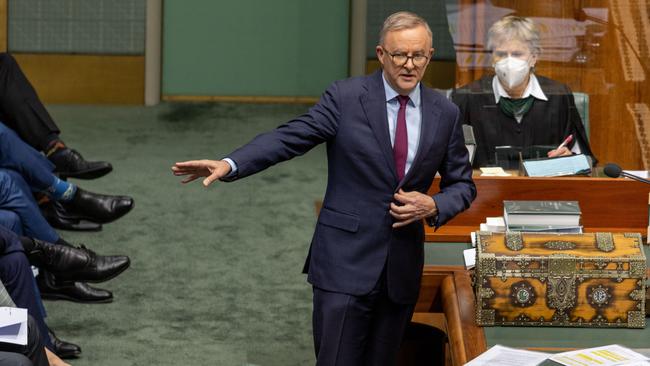
The challenges that existed before the May 2022 election have only grown. Albanese and Chalmers are grappling with a cost-of-living crisis alongside higher interest rates and rents exacerbating a growing housing crisis. There are demands on the budget to fund AUKUS and the Defence Strategic Review, and to curb runaway NDIS costs. There are calls to dump the legislated stage three tax cuts and allocate the funds elsewhere. The budget has been in structural deficit. The Economic Inclusion Advisory Committee and Women’s Economic Equality Taskforce recommended increasing the rate of JobSeeker, rent assistance and reintroducing the parenting payment for single women with children over age eight. Labor backbenchers have been pushing for increased welfare payments. Albanese was recently criticised for providing over $300 million for two stadium projects in Tasmania. These issues have led to prickly exchanges with journalists; he has taken to deploying a standard “you get one question” to limit interrogation.
A “substantial achievement” Albanese nominates is legislating an emissions reduction target of 43 per cent on 2005 levels by 2030 and net zero emissions by 2050, and the Safeguard Mechanism, winning support from business and unions. “My vision is cheaper, cleaner energy driving advanced manufacturing, particularly in the regions and in the outer suburbs, with high paid and high skill jobs,” he says. He adds that he is “really proud” of the National Reconstruction Fund, which is aimed at boosting manufacturing to make the economy more resilient. But perhaps the most significant, if successful, will be the referendum on the Voice to parliament and government. He says it is “a moment in history” and about “showing respect” to Indigenous Australians, “listening to them to get better outcomes” and being “more confident about ourselves as a nation”. It is also about our international standing. “The world is paying attention to the way Australia sees ourselves and whether we have the confidence to project the fullness of our history, including pride in sharing this continent with the oldest continuous culture on Earth,” Albanese says.
It’s 7.35 am the day after our Sydney interview and the prime minister’s armoured BMW 7 series with number plate C-1 and flag flapping on the bonnet zooms across the tarmac at Sydney Airport to his VIP Boeing jet. He bounds up the stairs and walks to the back cabin to talk to staff. He has been doing FM radio interviews, talking about everything from the Voice to rugby league and whether UFOs exist. Much of it, like social media, is targeted and off-radar. It may have been poor judgment for Albanese to attend Sydney FM radio king Kyle Sandilands’ lavish wedding to Tegan Kynaston, along with so-called colourful identities. But Albanese, with an eye to a referendum and re-election, tells me that FM radio is how he can engage with those who don’t engage with politics.

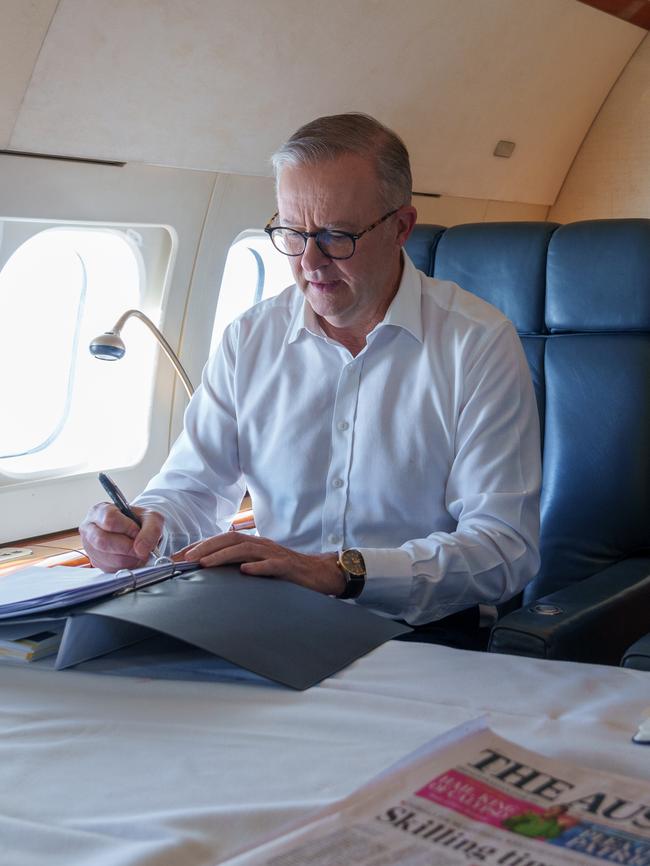
Six minutes after the PM’s arrival, the jet is taxiing to the runway and it is wheels-up at 7.50am, headed for Brisbane. Albanese is briefed by staff for the opening of the Coles distribution centre in Redbank, a street walk at the Orion Springfield Central shopping centre with local MP Shayne Neumann, and a meeting of the national cabinet the following day. Albanese’s team, led by chief of staff Tim Gartrell, operates with a mood of calm and relaxed good-humour, discipline and focus. The unspoken but obvious comparison is with Rudd, who operated in an orbit of perpetual chaos and tension, but none of that is evident. Gough Whitlam’s staff called him “leader”. Albanese’s staff call him either “PM”, “boss”, “Albo”, “Anthony” or, in front of others, “prime minister”. Albanese knew Gartrell when he was a teenager. They talk through the day as required. There are several staff who were friends from university and others who worked with him in opposition or as a minister in the Rudd-Gillard government. About half the staff are women and they are older than in most offices. Wisdom and experience are prized as much as youthful energy.

As breakfast is served, Albanese flicks through his briefing folders, asks questions and makes comments. He eats boiled eggs and bacon most mornings followed by salad for lunch, avoiding carbs; he permits the occasional beer or glass of wine. He begins each day by reading a briefing of the main news stories on his phone. He looks closely at newspaper front pages and opinion articles, and peruses print editions over breakfast. Albanese admits to being “very hands on” with his diary and over several days I notice him rescheduling things to fit better. He likes to annotate briefing papers but does not keep a diary. He is “paper-driven” and prefers to carry documents, unlike Malcolm Turnbull who used an iPad in an attempt to bring the prime ministership into the digital age. For speeches, Albanese will often dictate sections, discuss ideas with speechwriters and make handwritten amendments on drafts. For smaller events, speech notes are prepared but he usually speaks from his own notes. His social media accounts – Twitter, Facebook, Instagram and LinkedIn – are largely run by his staff, but if anything about the Rabbitohs is posted it is almost certainly from the PM himself.
There are seven members of the ex-PMs club. This requires deft handling. Keating has savaged the government’s foreign policy, especially AUKUS, and mocked Penny Wong’s Pacific outreach. “I don’t take it personally,” Albanese says about Keating. “I have no intention of being anything other than respectful.” Keating still speaks to ministers, and conferred with Albanese at Kirribilli House before the PM met Xi Jinping at the G20 summit. Howard wrote to Albanese congratulating him on becoming prime minister and wished him well. Rudd has been dispatched to the US as ambassador, with several ministers relieved he is out of the country. Albanese has talked to Howard, Abbott and Turnbull but has only texted with Morrison since the election. Abbott likes to press his views on a range of matters, which Albanese respects but does not always agree with. He also talks regularly with Peter Dutton and told him in advance that the next Quad Leaders’ Summit would be held in Sydney on May 24.
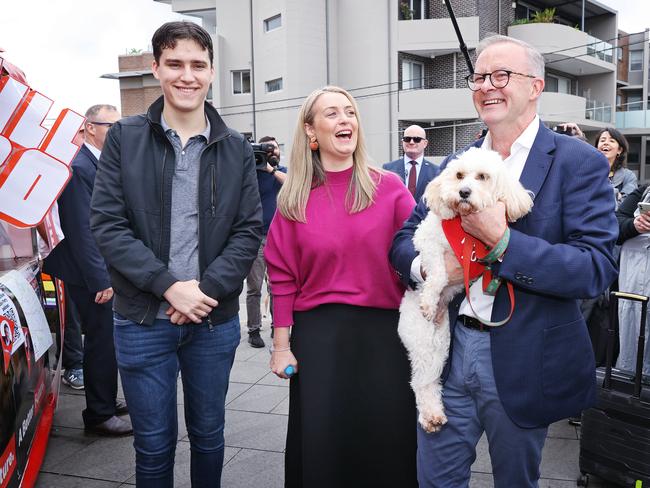
Turning 60 in March naturally prompts self-reflection. Albanese’s “greatest achievement” in life, he offers, is son Nathan with former wife Carmel Tebbutt. “[He’s] a really intelligent, funny, warm-hearted, good young man,” Albanese says. He adds that Nathan has been “very down to earth” about the transition to prime ministerial son. Jodie has also managed it with ease. “Jodie has done remarkably well for someone who doesn’t have a political background,” he says. “She has a confident sense of who she is, and she’s not trying to be anybody else.”
At 9.59am, the prime ministerial convoy arrives at Redbank for the Coles distribution centre opening. Albanese meets Queensland Premier Annastacia Palaszczuk and Oxley MP and Speaker Milton Dick, and changes into steel-capped boots and a yellow hi-vis safety vest. Asked by management if he has any questions before meeting staff, he jokes: “How do I look?” He takes the tour by foot and golf cart, and speaks to journalists surrounded by conveyer belts, flashing lights and workers carrying laptops to operate complex machinery. This $1bn facility, which will be powered by 100 per cent renewable energy by 2025, is an opportunity to talk about efficiency, productivity, safety and sustainability. A large red button is pushed, twice, and it is officially opened.
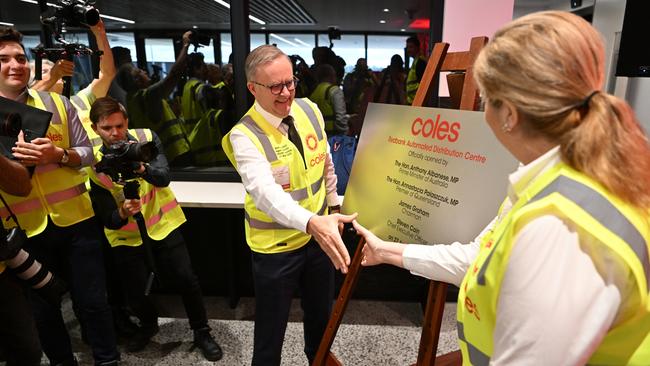
It is then off to the shopping centre in the electorate of Blair, which is the 75th seat Albanese has visited since the election. At 12.12pm, the prime minister steps out of his car and makes a beeline for a mother, and is soon cradling her baby, Ella. Shoppers rush for handshakes, pat him on the back and ask for a selfie. Seasoned politicians know to hold their phones at a certain angle to ensure it is done quickly and flawlessly. Hawke saw shopping centres as a way to build connections with voters. Keating famously said: “If I go to a shopping mall I go there to shop, I don’t go there to accost shoppers.” But it was the shoppers who crowded Albanese and he actually did shop, purchasing two bottles of fine hair conditioner. It is time for a quick meeting with business and community leaders corralled by Neumann. But first, Albanese cradles another baby and then orders a piccolo. “A very warm reception for the PM today,” Neumann says as Albanese exits the café at 12.50pm. “He’s a people person.” That afternoon, after checking into the Brisbane Hilton, Albanese meets with the President of Nauru, Russ Kun, and then has dinner with premiers and chief ministers ahead of national cabinet the following day. It is an exhausting pace.
Albanese says he is always thinking ahead: the next day, week, month, year. In 2019, when he became Labor leader, he was planning for the 2022 and 2025 elections. While political fortunes can turn quickly, there is no denying that after one year in power, the Albanese government is dominant. Polls underscore this. The Coalition is divided, engaged in either denial or soul-searching, and Dutton is unpopular. The Liberals lost the seat of Aston, the first time an opposition had lost a seat to the government at a by-election in more than a century. The Liberals hold their lowest proportion of seats in parliament since 1946, with Independents snatching their blue-ribbon electorates. As he seeks to remake the country in the most profound of ways, Albanese insists he is not complacent. “Every single day in this job is a great privilege,” he says. “I don’t take the next election for granted … the day when I take being prime minister for granted, it’s the time when I’ve probably been there too long. But I can’t imagine that happening.” Time, as ever, will tell. b





